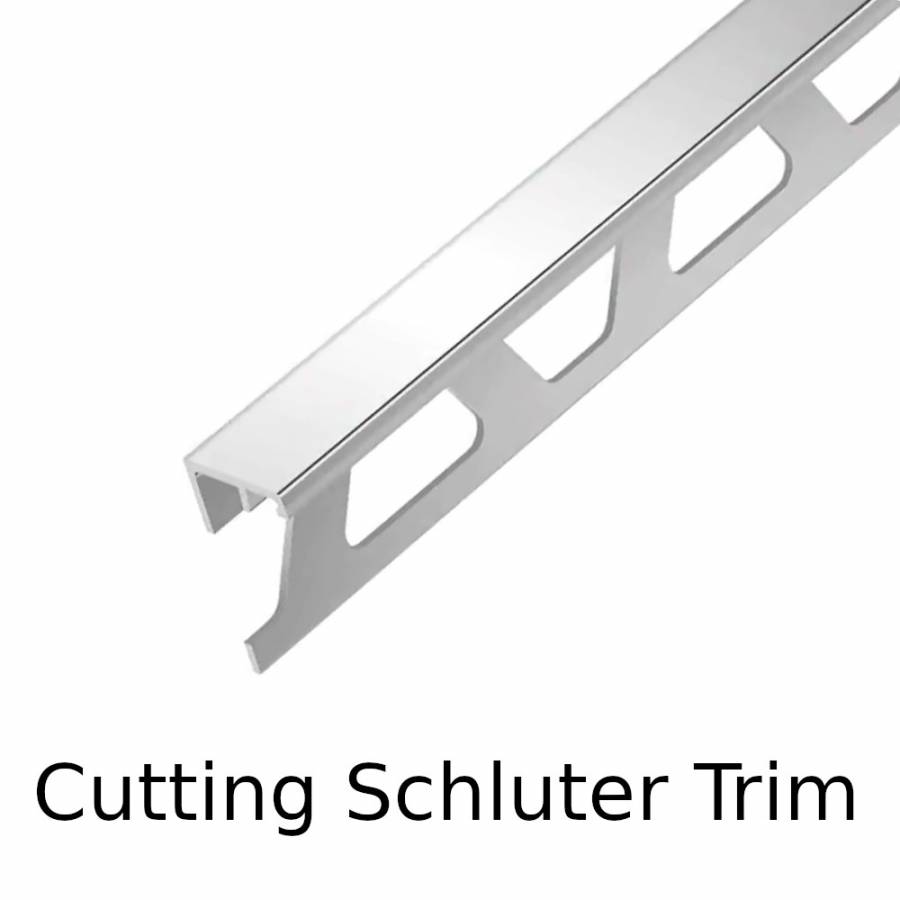Table of Contents
You may have noticed that after installing your tiles, the edges of the end tiles remain unprotected.
Sometimes, the edges also protrude, posing a health hazard if the rough edges graze someone’s arms or body. The general craft does not look appealing.
Consider using Schluter trim if you want your tile installation to last longer and look beautiful. But first, you should know how to cut it.
So, let us dive straight in and learn how to cut Schluter trim.

Here Is How To Cut Schluter Trim
You can use several methods to cut Schluter trim. It all depends on the type of installation you are doing.
Naturally, some installations require straighter, cleaner cuts while others do not so much.
The following section highlights the different methods to ensure you cut your profile correctly.
Use A Wet Saw
The most common way to cut Schluter trim is with a wet saw. You run your Schluter profile through the wet tile blade in this method.
While this method works quite well, it does leave rough edges (burs) on the cut. With this method, you do not get a clean-cut as you would with, say, a chop or miter saw.
Use A Chop Saw And An Aluminum Blade
However, if you want a clean, precise cut with well-fitting angles for miters, a chop saw, and an aluminum blade are the best options.
Ensure you are using aluminum profiles if you opt for this method. There are different blades for different profiles.
For example, if you are using stainless profiles, it is advisable to use a steel blade.
However, 90% of profiles are made of aluminum, so that an aluminum blade will suffice in most cases.
Clamp Your Profile In Place
You first want to ensure that you have marked the exact places you want to cut. After that, clamp the profile on the bench to prevent it from shifting.
Switch on the blade and cut at the marks you made.
Do not forget to wear goggles to protect your eyes from aluminum pieces that will fly around once you start cutting.
Also, remember to wear gloves to protect your hands.
Know-How To Use A Chop Saw
When using this method, the critical thing to remember is to know how to manipulate the chop saw.
This method is quite effective if you understand how to work the chop saw.
For instance, if you are cutting angle profiles, start by setting the chop saw to the required angle. Clamp your profile in place and cut.
Do not press the blade. For a clean cut, let the blade cut by itself.
Apply gentle pressure to keep the blade in place but not press down.
For the most part, the method you use to cut your profile will largely depend on the type of profile you are working on.
Therefore, the following section highlights the cutting techniques you can use for different profiles.
Plastic profile
You can use Schluter snips to cut plastic profiles. Make sure the blade is sharp enough to get a clean cut.
Aluminum profile
Most people use a hacksaw to cut aluminum profiles. Use a bimetal blade with the highest teeth per inch (TPI).
We recommend using a miter box to ensure you make a straight cut.
Using a variable-speed angle grinder with a Schluter cutting wheel, you can also cut aluminum profiles.
Ensure you set the angle grinder at the lowest speed. Secure the profile with a cutting jig or clamp to get a clean, straight cut.
A miter saw with a non-ferrous blade is also suitable for cutting aluminum profiles. Ensure you file off the burs before installing.
Note: Aluminum profiles tend to clog the spaces between the cutting teeth, so if you are using a saw blade, make sure it is not fine-toothed.

Brass profile
These are mostly cut using a hacksaw with a bimetal blade with the highest TPI. However, you can also use a chop saw with a non-ferrous blade.
Any burs left on the cut end should be filed off.
Stainless steel profile
The best option for cutting stainless steel is a variable-speed angle grinder with a Schluter cutting wheel (PROCUT-TSM).
Always set the angle grinder to the lowest speed.
For metal profiles, ensure the face of the metal faces up against the backstop of the miter saw.
You can also use a band saw with a metal cutting blade. Make sure you remove any burs on the cut end with a file before installing.
How To Bend Schluter Profile To Fit Around A Corner
You might want to protect the corners of your tile installation to prevent them from wear and tear. In such instances, you will probably use a Schluter profile.
Once you have measured the length of the corner, cut your profiles into equal lengths. A typical Schluter piece is 8 feet long and 3/8” wide.
It is taller than most wall edges. So, you will have to cut the Schluter according to the height of the wall.
After that, you can use a pair of dykes to bend the Schluter right down the middle. If you have a bend on the wall, cut a ‘V’ notch where you will bend the Schluter.
Horizontal parts of a wall are likely to have angles (e.g., if you are working on a kitchen sink). It allows you to bend the profile round the bend without much effort.
Just keep in mind that this works well with texture-coated aluminum profiles and straight aluminum profiles.
The color-coated aluminum profiles might not be ideal for bending because the color at the bend will peel off as the profile stretches.
So, you will end up with a partially discolored profile finish.
Other Things You Need To Know When Working With Schluter
If it is your first time working with Schluter, you may not know when to install the tile and when to install Schluter.
Always install the Schluter tile edge before setting the tiles as a rule of thumb.
Keep the right side facing down on the chop saw to cut Schluter effectively. Do not position the profile’s face against the chop saw.
Doing so will result in messed-up angles that will make your installation difficult. Further, keep the bottom tight on the base.
Most people use wood scraps to hold the profile in place to do this.
It is always vital that you choose the correct Schluter for your tiles. As a rule of thumb, the Schluter profile should correspond with the thickness of your tiles.
For example, if your tiles are 3/8” (10 mm) thick, you should go for a trim that is 3/8”. Remember that all trims are 98.5” long.
Summary
Install Schluter to give your tile or floor installation a clean, polished appearance.
Schluter is very easy to work with if you know a few basic techniques and have a little patience.
A few things to keep in mind: when cutting Schluter, use a blade that will give you a clean, straight cut. We have provided tips and guidelines on how to go about this.
